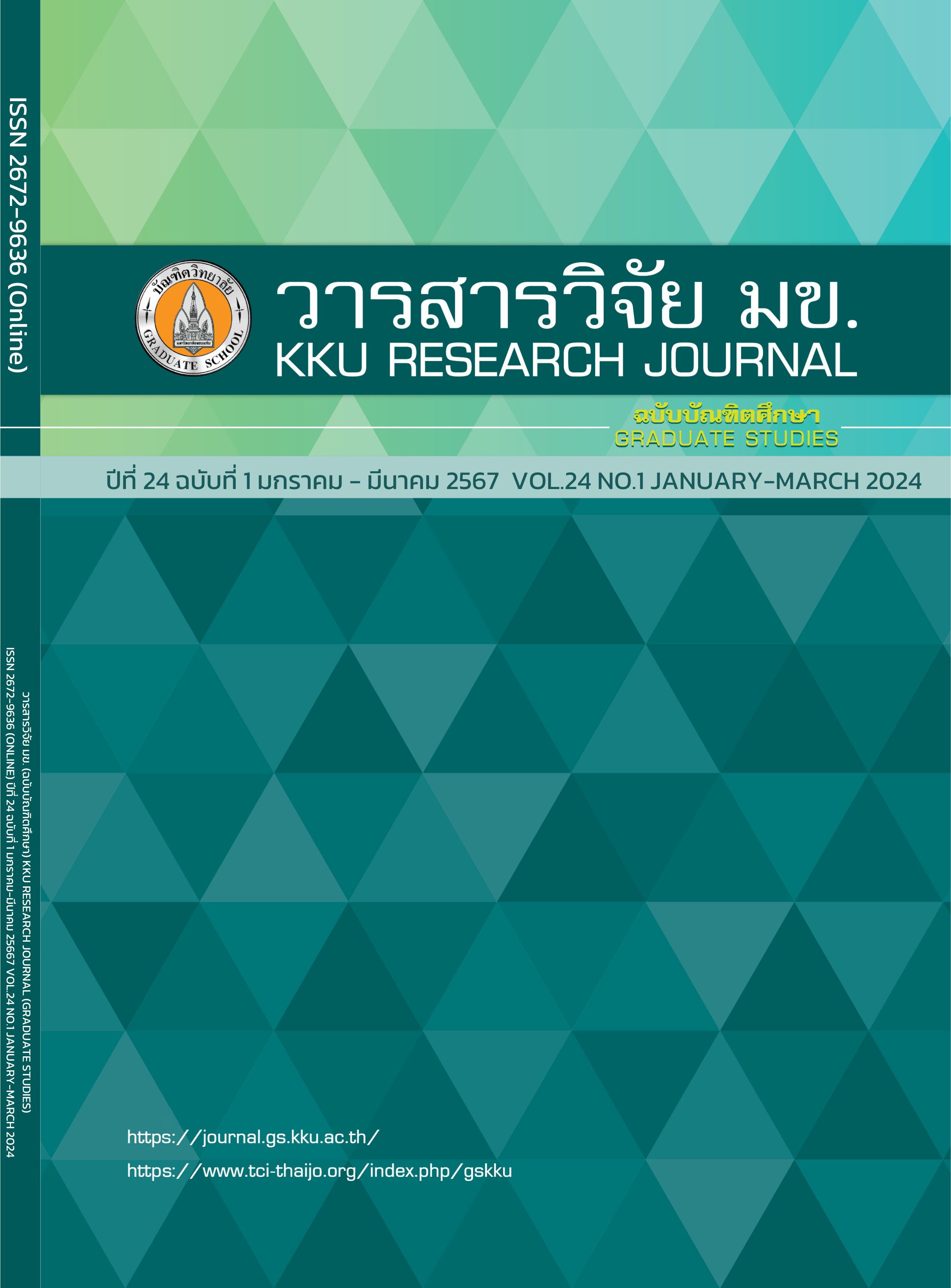Factors Influencing the Intention to Drink and Drive: A Case Study of Engineering Students, Khon Kaen University
Keywords:
Drunk driving, Theory of planned behaviour, Multi-Group AnalysisAbstract
The drunk driving results in losses for themselves and others. This study aimed to examine the factors influencing engineering students' intent to drink and drive and compare the developed model of first-year students to that of upper-year students. The study administered a questionnaire based on the theory of Planned behavior (TPB) to 558 students. The research employed descriptive statistics and a structural equation model (SEM) to explain the factors that influence drunk driving intentions. Multi-group analysis was used to assess the invariance of the measurement. This study found that factors influencing intention to drink-driving were perceived behavioral control and injunctive norms. This influence remained unchanged regardless of the year under consideration. However, the levels and correlation values for drunk driving intention, injunctive norms, perceived behavioral control, and drunk driving behavior were higher in those upper-year students. To reduce the intent of drunk driving Attention should be given to the cognitive factors controlling behavior, and it may be necessary to study more information on the controlling factors for drunk driving behavior of students.
References
World Health Organization. GLOBAL STATUS REPORT ON ROAD SAFETY 2018 [Internet]. 2018 Jun [cited 2022 Sep 30]. Available from: https://www.who.int/publications/i/item/9789241565684
Jinvong T. Road Accidents, the “Silent Threat” That is Challenging to Deal with Journal of Emergency Medical Services of Thailand. 2021; 1(1): 71-76. Thai.
The Land Traffic Act Update. Thai government gazette. 2017;134:1-2.Thai.
Thailand Accident Research Center. KEY FACTS ON ROAD SAFETY SITUATIONS IN THAILAND 2018-2021. 2022. Thai.
Ajzen I. The theory of planned behavior. Organ Behav Hum Decis Process. 1991;50(2):179–211.
Collins SE, Witkiewitz K, Larimer ME. The Theory of Planned Behavior as a Predictor of Growth in Risky College Drinking*. Stud Alcohol Drugs [Internet]. 2011 [cited 2022 Oct 16];72(March):322–32. Available from: https://doi.org/10.15288/jsad.2011.72.322
Potard C, Kubiszewski V, Camus G, Courtois R, Gaymard S. Driving under the influence of alcohol and perceived invulnerability among young adults: An extension of the theory of planned behavior. Transp Res Part F Traffic Psychol Behav. 2018;55:38–46.
Wechsler H, Lee JE, Nelson TF, Lee H. Drinking and driving among college students: The influence of alcohol-control policies. Am J Prev Med. 2003;25(3):212–218.
Vanichbuncha K. Analysis Structural equations with Amos. 4th ed. Bangkok. chulabook; 2019. Thai.
Haydon HM, Obst PL, Lewis I. Examining Women’s Alcohol Consumption: The Theory of Planned Behavior and Self-Identity. Subst Use Misuse [Internet]. 2018;53(1):128–136. Available from: http://dx.doi.org/10.1080/10826084.2017.1327972
Hagemeister C, Kronmaier M. Alcohol consumption and cycling in contrast to driving. Accid Anal Prev [Internet]. 2017;105:102–108. Available from: http://dx.doi.org/10.1016/j.aap.2017.01.001
Vestgård MU, Pokorny P, Svaboe GBA, Tørset T. Cycling under the influence of alcohol – Attitudes and perceptions of Norwegian cyclists. Travel Behav Soc. 2021;23(October 2019):134–142.
Huemer AK. Cycling under the influence of alcohol in Germany. Transp Res Part F Traffic Psychol Behav. 2018 Jul 1;56:408–419.
Labrie JW, Kenney SR, Mirza T, Lac A. Identifying factors that increase the likelihood of driving after drinking among college students. Accid Anal Prev. 2011 Jul;43(4):1371–1377.
Papadimitriou E, Theofilatos A, Yannis G, Cestac J, Kraïem S. Motorcycle riding under the influence of alcohol: Results from the SARTRE-4 survey. Accid Anal Prev [Internet]. 2014;70:121–130. Available from: http://dx.doi.org/10.1016/j.aap.2014.03.013
Triyabutra T, Satiennam W, Satiennam T. Application of the Theory of Planned Behavior (TPB) to study the factors effect to motorcyclist’s intention to run red light. Nation Conv Civ Eng. 2015. Thai
Tankasem P, Satiennam T, Satiennam W, Jaensirisak S, Rujopakarn W. Effects of automated speed control on speeding intention and behavior on mixed-traffic urban arterial roads. IATSS Res. 2022 Dec 1;46(4):492–498.
Downloads
Published
Issue
Section
License
Copyright (c) 2024 KKU Research Journal (Graduate Studies)

This work is licensed under a Creative Commons Attribution-NonCommercial-NoDerivatives 4.0 International License.



